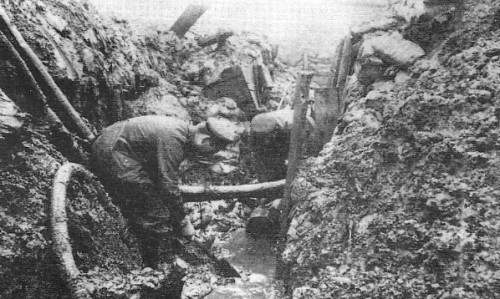The Story of the WWI Christmas Truce
It has become a great legend of World War I. But what really happened when British and German troops emerged from their trenches that Christmas Day?
By
Mike Dash
smithsonian.com
Even at the distance of a
century, no war seems more terrible than World War I. In the four years
between 1914 and 1918, it killed or wounded more than 25 million
people–peculiarly horribly, and
(in popular opinion, at least) for less
apparent purpose than did any other war before or since. Yet there were
still odd moments of joy and hope in the trenches of Flanders and
France, and one of the most remarkable came during the first Christmas
of the war, a few brief hours during which men from both sides on the
Western Front laid down their arms, emerged from their trenches, and
shared food, carols, games and comradeship.From This Story
Their truce–the famous Christmas Truce–was
unofficial and illicit. Many officers disapproved, and headquarters on
both sides took strong steps to ensure that it could never happen again.
While it lasted, though, the truce was magical, leading even the sober Wall Street Journal
to observe: “What appears from the winter fog and misery is a Christmas
story, a fine Christmas story that is, in truth, the most faded and
tattered of adjectives: inspiring.”
The first signs that something strange was
happening occurred on Christmas Eve. At 8:30 p.m. an officer of the
Royal Irish Rifles reported to headquarters: “Germans have illuminated
their trenches, are singing songs and wishing us a Happy Xmas.
Compliments are being exchanged but am nevertheless taking all military
precautions.” Further along the line, the two sides serenaded each other
with carols—the German “Silent Night” being met with a British chorus of “The First Noel“—and scouts met, cautiously, in no man’s land, the shell-blasted waste between the trenches. The war diary of the Scots Guards
records that a certain Private Murker “met a German Patrol and was
given a glass of whisky and some cigars, and a message was sent back
saying that if we didn’t fire at them, they would not fire at us.”
The same basic understanding seems to have
sprung up spontaneously at other spots. For another British soldier,
Private Frederick Heath, the truce began late that same night when “all
down our line of trenches there came to our ears a greeting unique in
war: ‘English soldier, English soldier, a merry Christmas, a merry
Christmas!’” Then–as Heath wrote in a letter home–the voices added:
‘Come out, English soldier; come out here to us.’ For some little time we were cautious, and did not even answer. Officers, fearing treachery, ordered the men to be silent. But up and down our line one heard the men answering that Christmas greeting from the enemy. How could we resist wishing each other a Merry Christmas, even though we might be at each other’s throats immediately afterwards? So we kept up a running conversation with the Germans, all the while our hands ready on our rifles. Blood and peace, enmity and fraternity—war’s most amazing paradox. The night wore on to dawn—a night made easier by songs from the German trenches, the pipings of piccolos and from our broad lines laughter and Christmas carols. Not a shot was fired.
image: http://blogs.smithsonianmag.com/history/files/2011/12/German-trench-500x299.jpg


A German trench in December 1914. Workmanship
was far less sophisticated than it became later in the war, and the
muddy conditions were terrible.
Several factors combined to produce the
conditions for this Christmas Truce. By December 1914, the men in the
trenches were veterans, familiar enough with the realities of combat to
have lost much of the idealism that they had carried into war in August,
and most longed for an end to bloodshed. The war, they had believed,
would be over by Christmas, yet there they were in Christmas week still
muddied, cold and in battle. Then, on Christmas Eve itself, several
weeks of mild but miserably soaking weather gave way to a sudden, hard
frost, creating a dusting of ice and snow along the front that made the
men on both sides feel that something spiritual was taking place.
Just how widespread the truce was is hard to
say. It was certainly not general—there are plenty of accounts of
fighting continuing through the Christmas season in some sectors, and
others of men fraternizing to the sound of guns firing nearby. One
common factor seems to have been that Saxon troops—universally regarded
as easygoing—were the most likely to be involved, and to have made the
first approaches to their British counterparts. “We are Saxons, you are
Anglo-Saxons,” one shouted across no man’s land. “What is there for us
to fight about?” The most detailed estimate, made by Malcolm Brown of
Britain’s Imperial War Museums, is that the truce extended along at least two-thirds of British-held trench line that scarred southern Belgium.
image: http://blogs.smithsonianmag.com/history/files/2011/12/truce-3-500x322.jpg


Men from the Royal Dublin Fusiliers meet
their German counterparts in no man’s land somewhere in the deadly Ypres
Salient, December 26, 1914.
Even so, accounts of a Christmas Truce refer to a
suspension of hostilities only between the British and the Germans. The
Russians, on the Eastern Front, still adhered to the old Julian calendar
in 1914, and hence did not celebrate Christmas until January 7, while
the French were far more sensitive than their allies to the fact that
the Germans were occupying about a third of France—and ruling French
civilians with some harshness.
It was only in the British sector, then, that
troops noticed at dawn the Germans had placed small Christmas trees
along parapets of their trenches. Slowly, parties of men from both sides
began to venture toward the barbed wire that separated them,
until—Rifleman Oswald Tilley told his parents in a letter
home—”literally hundreds of each side were out in no man’s land shaking
hands.”
Read more: http://www.smithsonianmag.com/history/the-story-of-the-wwi-christmas-truce-11972213/#vQhPdvZODOq6RXXI.99
Give the gift of Smithsonian magazine for only $12! http://bit.ly/1cGUiGv
Follow us: @SmithsonianMag on Twitter

No comments:
Post a Comment